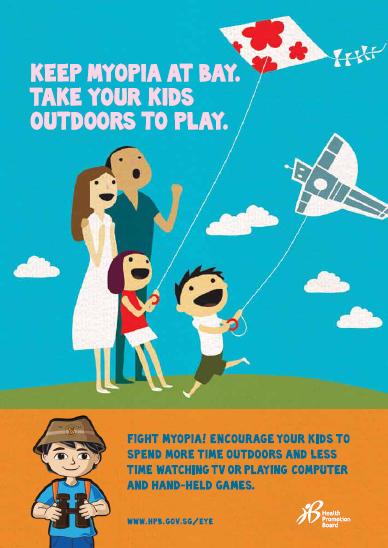EYE ON CHILD MYOPIA
 Remember this typical olden-day stereotype of bookish kids who wore thick glasses being ridiculed by street urchins who thought it more fun to play marbles in the kampongs than to bury themselves in books?
Remember this typical olden-day stereotype of bookish kids who wore thick glasses being ridiculed by street urchins who thought it more fun to play marbles in the kampongs than to bury themselves in books?
Today, being bespectacled has lost its social stigma – a pair of funky frames can now be used as a fashion statement. Ironically, it’s all because so many more people need spectacles to see clearly… and at a younger age too!
Statistics show that the prevalence of myopia in Singapore is one of the highest in the world. Compared to 1988 when about 16% of Primary 1 children and 50% of Primary 6 children had defective vision, the numbers now stand at about 30% of Primary 1 children and more than 60% respectively. What’s more, the proportion of Singaporeans with high myopia is much larger compared to those in Western populations.
What is myopia?
Myopia, or shortsightedness, is a condition when the eyeball is too long from front to back, causing the focal point of a visual image to fall in front instead of on the retina itself. Simply put, it means having a blurred vision, and therefore the need for prescription lenses to re-focus light rays onto the retina to see a clear image.
If your child is unable to clearly see far away objects like bus numbers, copies things wrongly from the board or starts to complain of headache or dizziness when trying to focus on far away objects, he or she may be showing symptoms of myopia.
Causes of Myopia
The factors that cause the development of myopia are not clearly known. Research has shown that both genetic and environmental factors can contribute to myopia. It is known that if one or both parents have myopia, the risk of the child having myopia is increased.
Near work means visual activities performed at a close distance, where a person needs to look at or focus on fine details of an object. Examples of near work are reading, writing, watching television, using the computer, drawing/painting, sewing, doing craft work with small objects and playing hand-held games. Engagement in too much near work may be a reason why more children need to visit the optometrist for their first pair of spectacles at a younger age. There is also new evidence now that shows that regular outdoor activity can protect against myopia.
Problems Associated with Myopia
Childish taunts and nicknames like “four eyes” may no longer sting these days, but glasses can still be cumbersome, especially for young kids. Many of them tend to misplace them or accidentally break them. This not only causes a financial strain on the parents but increases the likelihood of worsening myopia. Severe myopia can lead to future complications like blindness. In addition, having imperfect eyesight can affect self-esteem as well as cramp one’s lifestyle for example when it comes to engaging in sporting activities. That is why people resort to wearing contact lenses or opt for Lasik surgery when they grow up.
Parents can Play a Part
Michael Lim has a 28-month old son and thinks it’s never too early to cultivate healthy eye care habits among children. “I’m always conscious not to let my son go too near to the TV.” Like him, another parent, Cherie Chee encourages her 5 year old girl to go outdoors to play every evening. Incidentally, Cherie and her husband both have perfect eyesight and are keeping their fingers crossed that their “good genes” have been passed down to their daughter!
You can’t take away computers and electronic devices, but you can still limit their use among children to give their overworked eyes a breather. So the next time your child gets too engrossed with his racing game on the PSP or her Cooking Mama on the Nintendo DS, impose a break or make him/her engage in another activity preferably one which involves going outdoors.
The importance of outdoor activity in having a protective effect on myopia cannot be undermined. Help your child appreciate the outdoors! Admire the soothing greenery, bask in the sunshine, enjoy the freedom of frolicking on the beach – not only does outdoor activity help to fight myopia, but the physical exercise can improve your little ones’ health too.
You should also remind your child to reduce time spent on unnecessary near work and take a three- to five-minute break after every 30-40 minutes of near work activity like reading or playing hand held games. Taking breaks between near work activities is advocated at Spark Learning Centre, where computer-based enrichment classes are conducted for kids from Kindergarten 2 to Primary 5. Dr Uma, President of Spark says: “At our centers, we give our students a break between their 1-hour computer sessions to engage in other mind games like chess or Tangram. We also provide adequate lighting so that there is less chance of eye strain.”
As a parent, there’s not much you can do with regards to your child’s myopia-causing DNA, but you can certainly play a part in preventing the onset of shortsightedness or reducing your child’s risk of developing severe shortsightedness by monitoring his/her lifestyle choices.
This article is part of Health Promotion Board’s continued efforts in educating parents on myopia. Also look out for our next article in Kiasuparents.com, which will discuss common questions and debunk myths and beliefs regarding myopia.
Article contributed by Health Promotion Board.
For more information on Myopia, visit the Health Promotion Board website.
